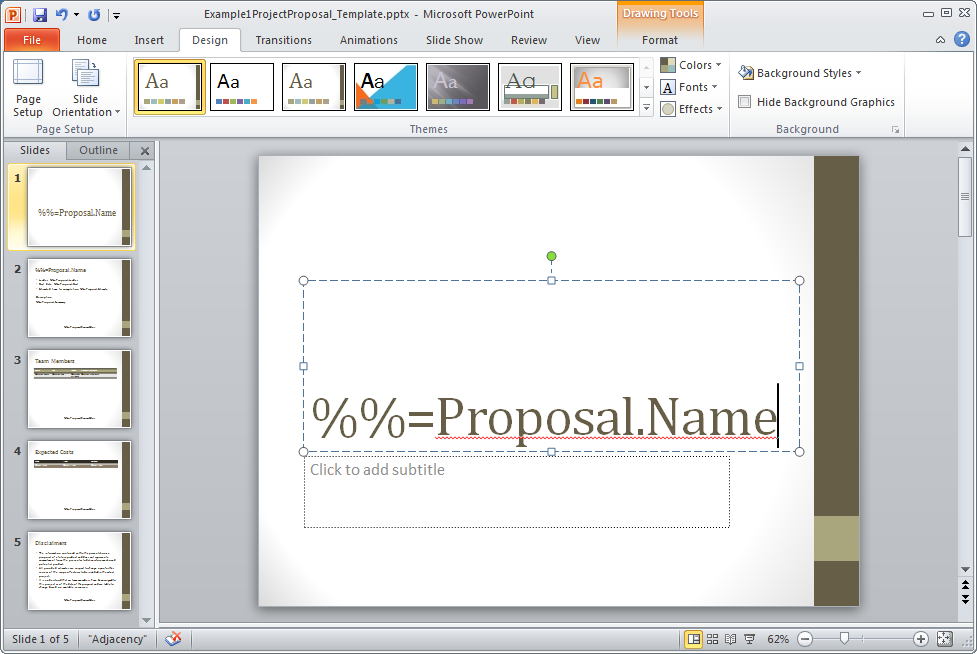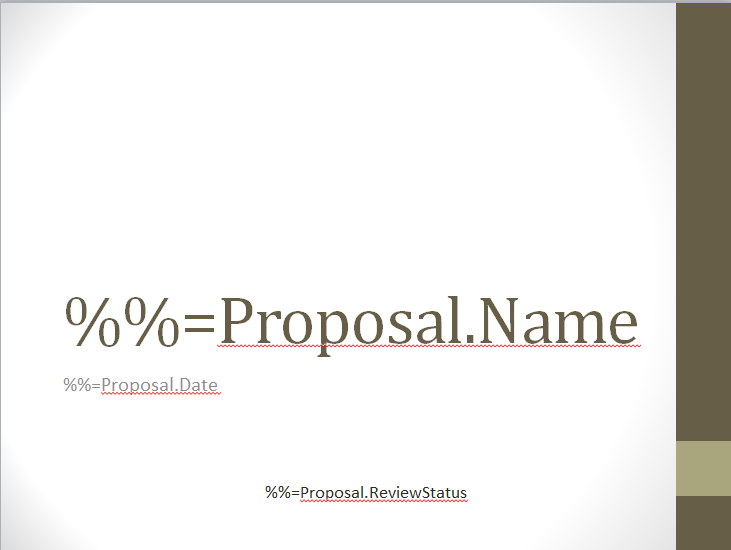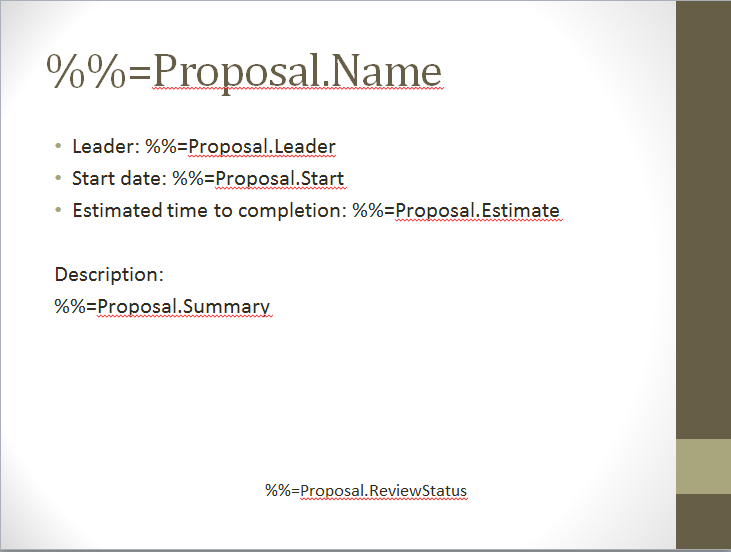Table of Contents |
|---|
Setting up the Template
About templates and data markers
A PowerPointWriter template is a PowerPoint presentation that contains PowerPointWriter data markers. A data marker is a line of text beginning with %%= that specifies a database column, variable, or array to insert into the presentation. PowerPointWriter supports data markers embedded in text. Data markers are added to a presentation in PowerPoint and then bound to data sources in code. PowerPointWriter populates the data markers with values from the data sources when the code is executed. Part 1 of this tutorial demonstrates how to use data markers to import single rows of data.
Data marker syntax
The basic syntax for a data marker is %%=[DataSourceName].[ColumnName], where DataSourceName is the name of the data source and ColumnName is the name of the column in the data source. You need to follow these rules when naming data markers:
- Names must begin with a letter (A-Z, a-z)
- The brackets (
[]) are optional, but must be used when the data marker contains spaces or Unicode characters- The following is a list of characters allowed in data marker names without brackets: ABCDEFGHIJKLMNOPQRSTUVWXYZabcdefghijklmnopqrstuvwxyz1234567890_
- Names must exactly match the names in the data source.
- If a column in a database is 'Street Address', the
ColumnNamemust be[Street Address]to account for the space. Similarly, if a data source name is "DataSource1", the data marker name must beDataSource1or[DataSource1].
- If a column in a database is 'Street Address', the
For more specific information about creating data markers, see How to use Data Markers
Adding data markers to the the template
The template for Part 1 consists of 2 slides populated with text and data markers.
1. Start with a blank .pptx file. Save the file as part1_template.pptx.
2. Set the presentation theme by going to the Design tab.
3. Add 3 text boxes to the first slide and populate the one you want to use as the title with the data marker %%=Proposal.Name

In the other two text boxes, add the %%=Proposal.Date, %%=Proposal.ReviewStatus data markers. The final slide should look something like the one below.

4. Add a new slide to the presentation. This slide should consist of two text boxes, one for the title and a large one for the body of text. In the title text box, place the data marker %%=Proposal.Name. Note that this is the same as the data marker used on our first slide.
The rest of the slide will contain additional data about the proposal from the 'Proposal' data source. The data markers we are adding are: %%=Proposal.Leader, %%=Proposal.Start, %%=Proposal.Estimate, %%= Proposal.Summary and %%=Proposal.ReviewStatus. Because PowerPointWriter supports data markers embedded in text, we only need one text box for this information.
The finished slide should look like the one below.

Adding a PowerPointWriter Reference in Visual Studio
Create a .NET project and add a reference to the PowerPointWriter library.
- Open Visual Studio and create a .NET project.
- The sample code uses a web application.
- Add a reference to SoftArtisans.OfficeWriter.PowerPointWriter.dll
- SoftArtisans.OfficeWriter.PowerPointWriter.dll is located under Program Files > SoftArtisans > OfficeWriter > dotnet > bin
Writing the Code
1. Include the SoftArtisans.OfficeWriter.PowerPointWriter namespace in the code behind
2. In the method that will actually create the presentation, instantiate the PowerPointTemplate object.
3. Open the template file for the presentation.
4. Create a DatabindingProperties object for binding data to the template.
5. Create two arrays to hold the values for the presentation. The first is the array of values to add to the presentation. The second contains the column names. The column names values must match the data markers in the template.
6. Bind the data to the template. Make sure the data source name is the same as the name used in the template.
7. Call process to import the data into the template and save the file.
Final Code
Downloads
You can download the code for the Basic PowerPointWriter Tutorials as a Visual Studio solution, which includes the Project Proposal.
